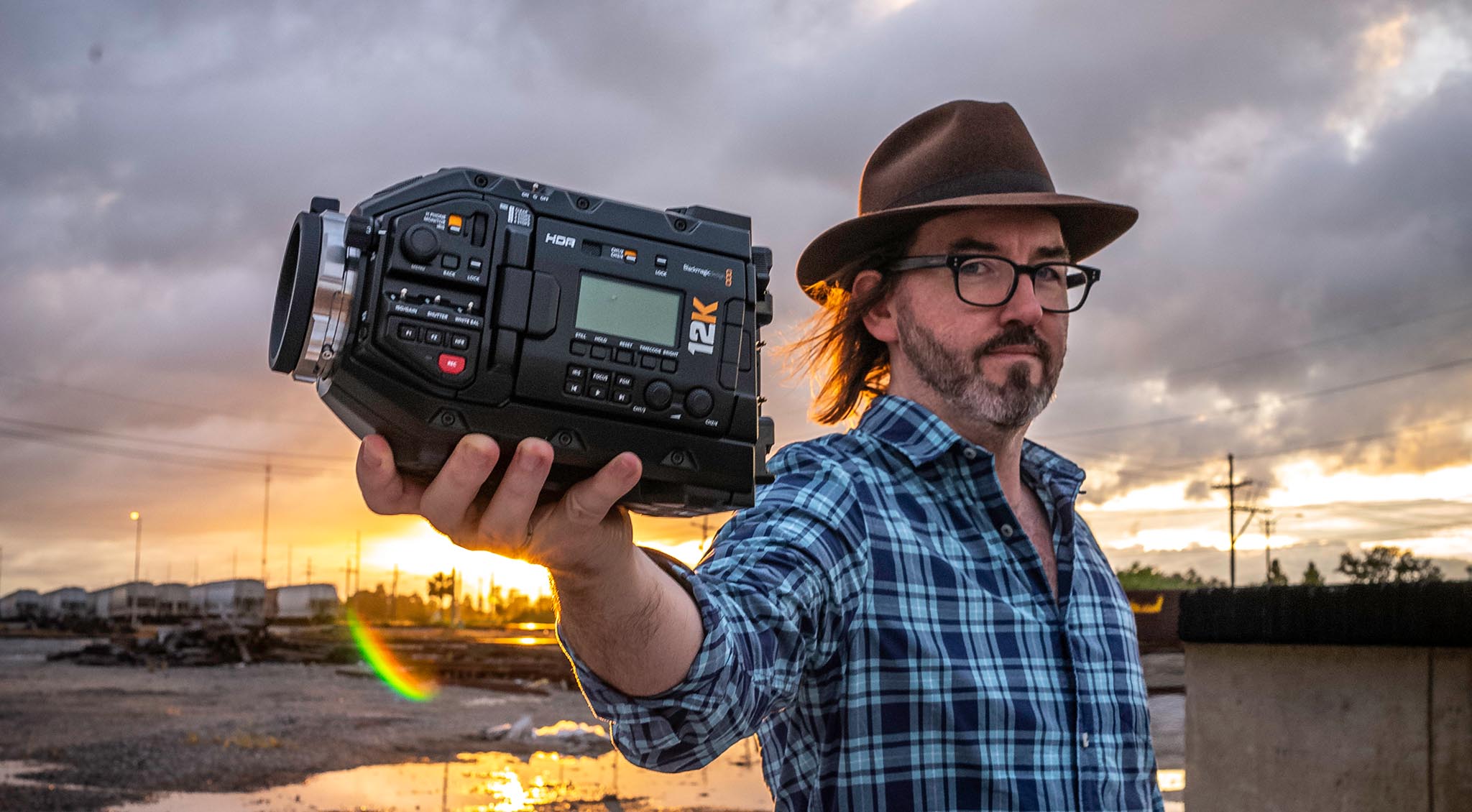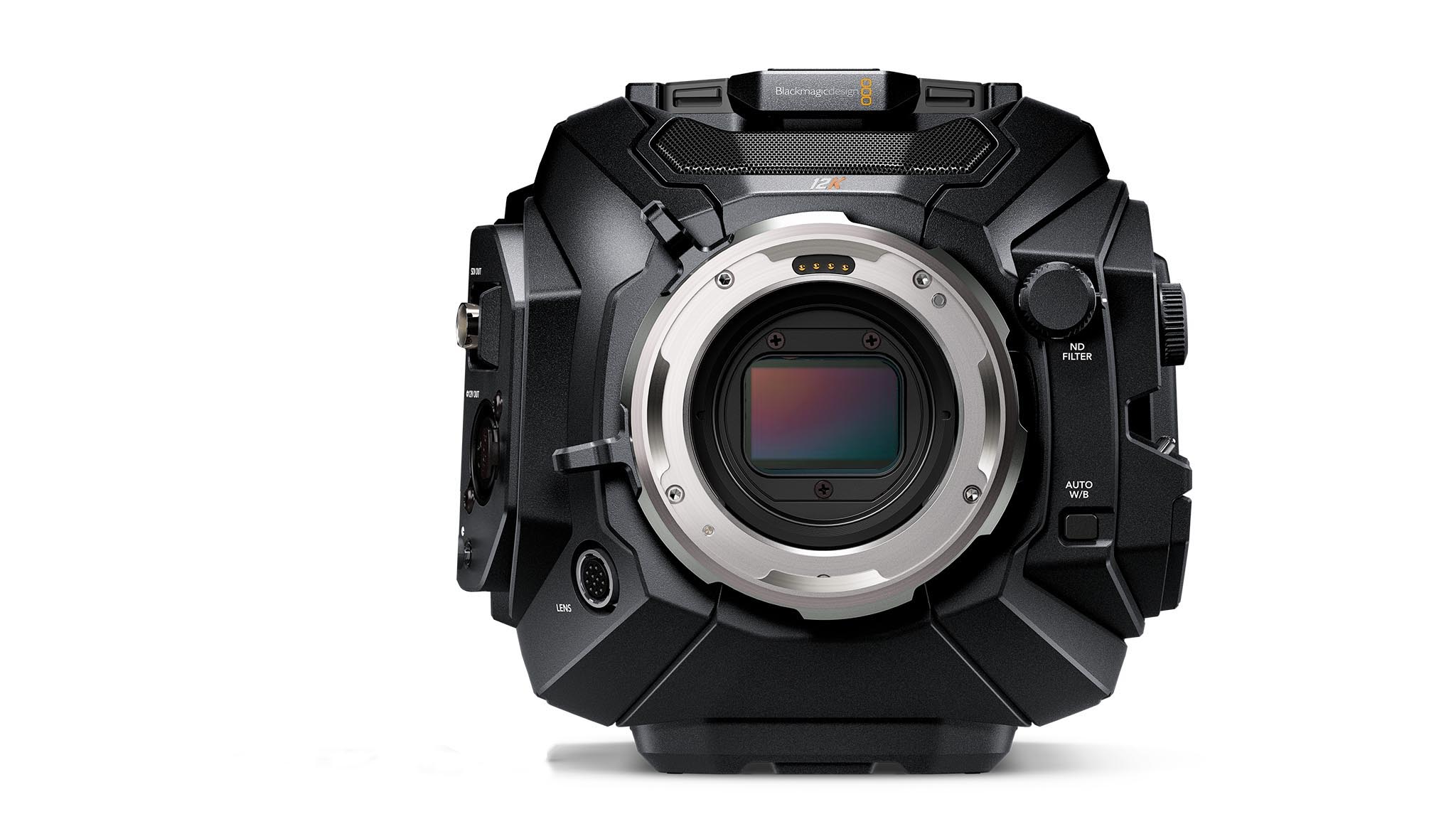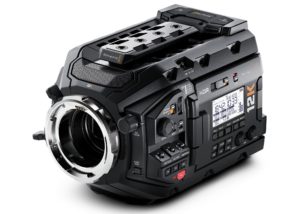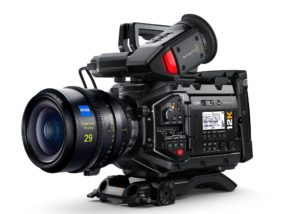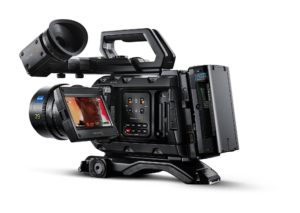Blackmagic Design URSA Mini Pro 12K
July 16, 2020. Melbourne, Australia. Grant Petty introduced the latest Blackmagic Design URSA Mini Pro 12K. It has a 12,288 x 6,480 12K Super35 image sensor, 14 stops of dynamic range, and shoots up to 60 fps in 12K at 80 megapixels per frame as well as 8K up to 110 fps, and 4K DCI full sensor up to 110 fps.
Grant said that Blackmagic Design was aiming for the high end with this affordable camera. “It’s not just the 12K sensor, but so many other innovations…Generation 5 Color Science, in-sensor scaling, new symmetrical color pattern and 12K resolution. It’s going to be exciting to see what cinematographers do creatively with this technology.”
One of the first cinematographers to try it was The Great John Brawley. His demo footage showed silky smooth skin tones, gorgeous color and low to no noise. (vimeo.com/436209544). Brawley said, “The picture quality is fantastic. And the 12K Blackmagic RAW footage that I showed you was cut on my 2017 MacBook Pro with a standard drive.”
12K Super35
The sensor is 27.033 mm wide x 14.246 mm high. The pixel pitch is not published yet, but if you divide 27.03 by 12, 288, you get approximately 2.2 microns. That’s tiny, and yet the URSA Mini Pro 12K has 14 stops of dynamic range and a native ISO of 800. How do they do this?
The sensor does not have a typical Bayer pattern. Grant called it a symmetrical sensor pattern. John Brawley writes, in his Ramblings of a Cinematographer blog, “Blackmagic’s 12K sensor uses a brand new custom filter array that has an equal number of red green and blue photosites as well as the addition of clear or ‘white’ photosites. It’s like HDR images can be created by combining two brightness values, so we can now combine the brightness and extra sensitivity of the W photosites along with the color pixels to get an extended dynamic range, helping to overcome the issue of making these new better pixels so much smaller.
“Normally reducing the pixel size to be so small means the light sensitivity is sacrificed, but this is more than compensated for by using the unfiltered W pixels. By combining the brightness values of those W photosites with the colored photosites, it also greatly increases the dynamic range compared to a standard Bayer array.” (johnbrawley.wordpress.com)
Brawley clearly has a Melbourne origin home-team advantage and impunity when he continues, “The 12K camera is a result of three years of work on a custom sensor design. Think about that for a moment. BMD threw millions of dollars at developing their own 12K sensor three years ago, from scratch, when you would struggle to even get 8K. Somehow they managed to keep this a secret for all that time. While BMD have highly customized and adapted other sensors previously, this is the first sensor that BMD have designed completely from scratch with their own IP and design… and I think shows their ongoing maturation as an imaging company.”
So, Blackmagic Design designs the 12K sensor, builds the camera, implements Blackmagic 12-bit RAW and drives DaVinci Resolve. That’s pretty much the entire imaging food chain within their grasp. That’s compelling.
Another nice thing about the sensor is that you can scale the image from 12K to 8K or 4K without cropping or binning. You can shoot the same scene with the same lens and field of view.
URSA Mini Pro 12K
If it’s windowing one wants, dust off those cherished Super16 lenses and shoot in Super16 format at 6K up to 120 fps or 4K up to 220 fps.
The camera comes with a PL mount. You can swap it with optional EF or F mounts. There are built-in ND filters, CFast and UHS-II SD media slots. The USB-C connector, with 10 Gb/s data rate, lets you can attach an SSD or NVMe drive. The BNC connector at the front camera right side provides HD SDI (up to 3G) and the rear BNC provides 4K SDI (up to 12G) output.
Bob Caniglia, Blackmagic Design Director of Sales Operations, North America, explained efficiencies of 12K: “On its own, 12K is obviously a huge number. In order to shoot 12K or 8K or any of these larger formats, you truly need to be able to use it. One of the challenges set out from the start of this project was to be able to have hardware over-sampling to make 8K files or 4K files from the 12K files, but to be able to do it without requiring a supercomputer.
“It was a combination of our managing the color science, having Blackmagic RAW, developing the sensor and having DaVinci Resolve Studio (included with the camera) on the back end to deal with the files. For example, this camera enables you to shoot 12K plates for VFX. For 8K or 4K, the camera does in-camera hardware scaling. And,if you’re shooting vertical video, you get a 6K vertical format.
“The UI is familiar to users of our other cameras. There’s constant quality and constant bit rate.
“Constant bit rate is a defined compression of 5:1, 8:1, 12:1 or 18:1. The bit rates vary. 12K 5:1 at 24 fps is close to 600 megabits per second. 18:1 in 12K at 24 fps gets it down to 160 megabits per second.
“Constant quality choices are Q0, Q1, Q3 and Q5. It means shooting with the best quality and varying the compression depending on the scene. If I’m filming you in front of a blank wall, it can use a lot more compression to compress those areas because there’s nothing else going on in the background. Whereas, if you were running down a street, it would require less compression to get that quality because there’s a lot more fine detail.
“In Q0, the highest quality, your bit-rate could be anywhere from 241 megabits per second to 578 which is compression of anywhere from about 5:1 to 12:1, depending on the scene. When you get to Q5, that’s constant quality with the most compression, anywhere from 72 to 180 megabits per second.”
BLACKMAGIC URSA Mini Pro 12K Summary
- 12,288 x 6480 12K Super35 sensor.
- 14 stops of dynamic range and native 800 ISO.
- Real-time Blackmagic RAW 12K editing.
- Up to 60 fps in 12K, 110 fps in 8K, and 220 fps in 4K.
- Dual card CFast recording at up to 900MB/s.
- PL mount included; EF and F mounts available.
- USB-C for recording up to 10 Gb/s to external disks.
- Includes DaVinci Resolve Studio for post production.
- Compatible with new Blackmagic URSA Mini Recorder.
- 5.92″ W x 9.2″ L x 5.78″ H; 5.62 lb.
Blackmagic URSA Mini Pro 12K will be available soon for around US $9,995, excluding duties or tax, from Blackmagic Design resellers worldwide.
(This is a “reprint” from August 2020 FDTimes issue 104.)

